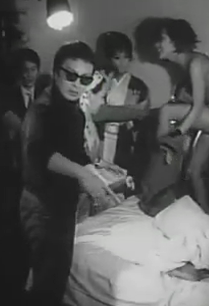
Matsumoto Toshio (松本俊夫), a major figure in postwar Japanese cinema and film theory, passed away on 12 April 2017 at the age of 85. This is a great shock to me, not only because of his immense contributions to Japanese film and image culture, but also because of all the help he provided for my career.
Matsumoto-san is of course well known for his work as a feature film director, with Funeral Parade of Roses (the photo at the right is of him in the film) and Dogura Magura being two of his most famous works. He started out in documentary, however, joining Shin Riken after studying aesthetics at the University of Tokyo. It was through documentary that I first came to know him. In 1993, the Yamagata International Documentary Film Festival did a retrospective of Japanese documentaries of the 1960s, curated by Yasui Yoshio of Planet, which featured four of Matsumoto-san’s films: Nishijin (1961), The Song of Stones (1963), Mothers (1967), and For My Crushed Right Eye (1968). One of my first tasks for the YIDFF was translating much of the retro catalog, so I first read Matsumoto before seeing his works. While Mothers was the least interesting of the four, his exploration of the image—from the still photographs of The Song of Stones to the multi-projector For My Crushed Right Eye—stood out amid the documentary of the time.
Matsumoto’s exploration in documentary was fueled by his own theoretical conceptualization of the moving image. This was the time of the eizoron (映像論) debates and Matsumoto, involved in editing some of the crucial journals of the time, was in the lead in thinking about new images to fit a different, postwar world. His book, Eizo no harken (“Discovery of the Image,” 映像の発見, 1963), a collection of his essays from the late 1950s on, was quite influential as Matsumoto can be considered central to the conceptual development of the Japanese New Wave. Markus Nornes and I recommended his “Theory of Avant-Garde Documentary” for translation in Cinema Journal (a job nicely done by Michael Raine, who added a very helpful introduction). While primarily an assertion that only a dialectical relationship between avant-garde form and documentary could capture a post-Hiroshima reality, the piece is also a compelling argument for a new relation between cinema and the subject.
My first real encounter with Matsumoto-san was when I interviewed him for the YIDFF’s Documentary Box. It was a very good interview, with Matsumoto quite effectively explaining his approach to cinema. But I did not push him hard enough. As others criticized me later, I failed to ask him about his conflicts with others in the counter culture at the end of the sixties, especially over his decision to participate in the Osaka Expo in 1970. That for him became one occasion to expand his work in into media and video art (he was one of the pioneers of experimental video), helped by the corporate support the Expo had.
Admittedly, I never really saw Matsumoto-san as a radical. My main relationship with him was academic. He himself began teaching at university in the 1980s, first at the Kyushu Institute for Design, then Kyoto University of Art and Design, and finally at Nihon University. It was when Matsumoto-san was president of the Japan Society of Image Arts and Sciences in the late-1990s that he appointed me to the board of directors, hoping to add new blood to the JASIAS. I was honored that he would think of me and grateful for the boost that appointment gave to my career. Sitting in on board meetings with him did reinforce my impressions of him: a bit stiff and stuffy, but also a very calm, rational, intellectual, and gracious human being. Knowing Matsumoto this way, Funeral Parade of Roses seems to me a Matsumoto film not just because of its bold experimental aspects, but also for its occasionally anthropological, if not academic approach.

The last event I did with him was in 2006 for a YIDFF-related screening in Tokyo, where I moderated a discussion between him and Kawaguchi Hajime (photo on the left). I still met with him a number of times over the last few years, even as his health was in decline. I am particularly thankful for him opening up time and allowing me to do a long interview with him at his office at Nihon University as part of my research on the history of Japanese film theory. He will play a prominent role in my book.
As both a scholar and a film fan, as both a member of the audience and a member of his board of directors, I am deeply indebted to Matsumoto Toshio and his work. 大変お世話になりました。ありがとうございました。ご冥福をお祈りいたします。

